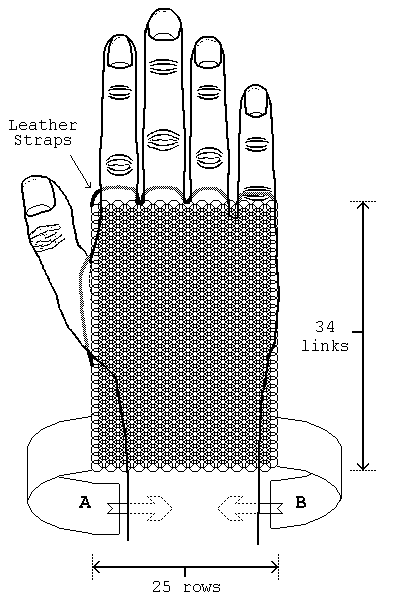
This pattern was described to me through e-mail, by Net citizen, Matt Clymer. It is a pattern for a simple but clever chain gauntlet which covers the bottom half of the back of the hand, from the wrist to the fingers.

Begin by making a rectangle of maille in either a European 4-in-1, 6-in-1, or 8-in-1 style. It should be large enough to completely cover the back of the hand. The maille should be oriented such that the links can expand when the maille is made into a fist. Small leather laces should be used to tie the top of the maille to the four fingers. It is best if the ties can be tightened and loosened for ease in taking off and putting on the gauntlet. A fifth strap should be added to the side of the maille to attach it to the thumb. It is especially important that this tie is adjustable because the number of links that are positioned over the thumb may change as the gauntlet is expanded when a fist is made. I would recommend using simple black or brown leather laces which can be bought nearly anywhere for about a dollar.
The maille needs to be attached near the bottom in such a way that it fits around the wrist comfortably. There are a number of ways that this can be done. One way would be to attach a 1 inch thick leather strap to the maille and have it wrap around the wrist. The attachment can be done with a snap or some hooks and eyes, or with simple lacing. A second way to achieve this attachment would be to expand the maille in a small strip around the wrist (also about 1 inch thick). It this case, a metal hook can be attached to one end and hook directly into the links on the other (making it completely adjustable).
If 3/16 inch links are used with 16 awg steel, a medium sized gauntlet can be made out of 25 rows of 34 links apiece. These links are so small, that the resulting maille lets very little light through, forming a very tight weave. You will have to experiment with other sizes to fit your hand. I would recommend, however, that the smallest size possible be used because it yields a better looking (and better protecting) gauntlet.
Clearly, this pattern requires little time and effort compared to most chain projects, and it can be used as a stepping stone for those who are looking to experiment with making more complicated gauntlets. Normally I can't personally guarantee the usefulness or the feasibility of patterns contributed by other armourers, but I have tried these myself based on Matt's description, and they work out quite nicely (and look pretty sharp as well). If you have specific questions about this pattern, you can email me, or ask Matt directly.